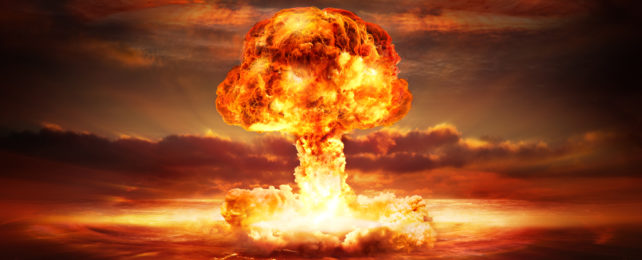If a nuclear bomb were dropped in your city tomorrow, would you know where to take cover? Nuclear war is a terrifying thought, but for a team of researchers at the University of Nicosia in Cyprus, it's top of mind.
In a recent study, the researchers calculated how the blast from a nuclear explosion could affect people sheltering indoors and found that even if you're at a safe distance from the explosion to survive the blast, you may still be in immediate peril.
"It is important to understand the impact on humans indoors to provide recommendations for protecting people and assets," said co-author Dimitri Drikakis. "For example, we can design structures that offer more protection."
Avoid hallways and doors. Seek out corners of windowless rooms
When a nuclear bomb detonates, it generates not only radiation in the form of a bright, blinding light and scorching heat but also powerful shockwaves that can travel for tens of miles.
It's these shockwaves that are potentially lethal for people at a safe enough distance from the fireball.
The team simulated a nuclear explosion from a 750-kiloton atomic bomb. For reference, the bombs the US dropped at Hiroshima was 15 kilotons, and at Nagasaki was 25 kilotons. So, on average, that's about 37 times smaller than the bomb in the researchers' simulation.
A warhead of this magnitude would likely obliterate everything within 2.5 miles (4 kilometers), but people beyond that radius may stand a chance if they're sheltering in the right location of a sturdy structure.
Where that right location is, however, is where the researchers' results get interesting.
"The explosion was simulated using high-resolution and high-order computational fluid dynamics," based on three decades of experiments and theory, Drikakis told Insider.
Using these models, they computed how the shockwave would move through buildings – including rooms, walls, corners, doors, corridors, windows, and doorways – at distances of 2.5 miles to 30 miles from the detonation site.
They reported that narrow pockets inside buildings like doorways and hallways could act like a wind tunnel, accelerating the shockwave to dangerous pressures of up to 18 times a human's body weight – easily enough to crush bones.
"The most dangerous critical indoor locations to avoid are the windows, the corridors, and the doors," said co-author Ioannis William Kokkinakis.
The best location is in the half of the building farthest from the blast, in a room with no windows. But, "even in the front room facing the explosion, one can be safe from the high airspeeds if positioned at the corners of the wall facing the blast," Kokkinakis told Insider.
It's also worth noting that the building itself is important. You don't want to take cover in a log cabin, for example.
"As the paper noted, if you're too close to the blast, there's not much that can be done. However, at a distance, building structures, particularly stone or concrete or other stout, noncombustible materials, can provide some degree of protection from the blast," said Kathryn Higley, a professor of radiation biology at Oregon State University who was not involved in the study.
Preparing for an uncertain future
The researchers said they modeled the detonation of a 750-kiloton bomb after Russia's Sarmat, an ICBM the Kremlin test-fired last April.
Russia's invasion of Ukraine has raised concerns that we may be inching closer to nuclear war, and one of their prime motivations for the study was "the growing rhetoric about the use of nuclear weapons," Drikakis said.
"A nuclear war is a serious matter that will lead to widespread destruction. For several decades, the international community has considered that such a possibility will not arise. However, the rhetoric around the globe has changed," Drikakis said.
The authors believe these findings could help nuclear safety experts devise better strategies to mitigate the damage from atomic explosions and radiation leaks. They hope the results from the study might also guide the development of nuclear-blast-proof buildings in the future.
"The wide-scale implication of this research is that it can add to the understanding of how to best protect yourself in the event of a nuclear detonation," Higley said.
Never mind the nuclear fallout and apocalyptic lifestyle you may face after the fact. Surviving that is a different sort of study, entirely.
This article was originally published by Business Insider.
More from Business Insider: